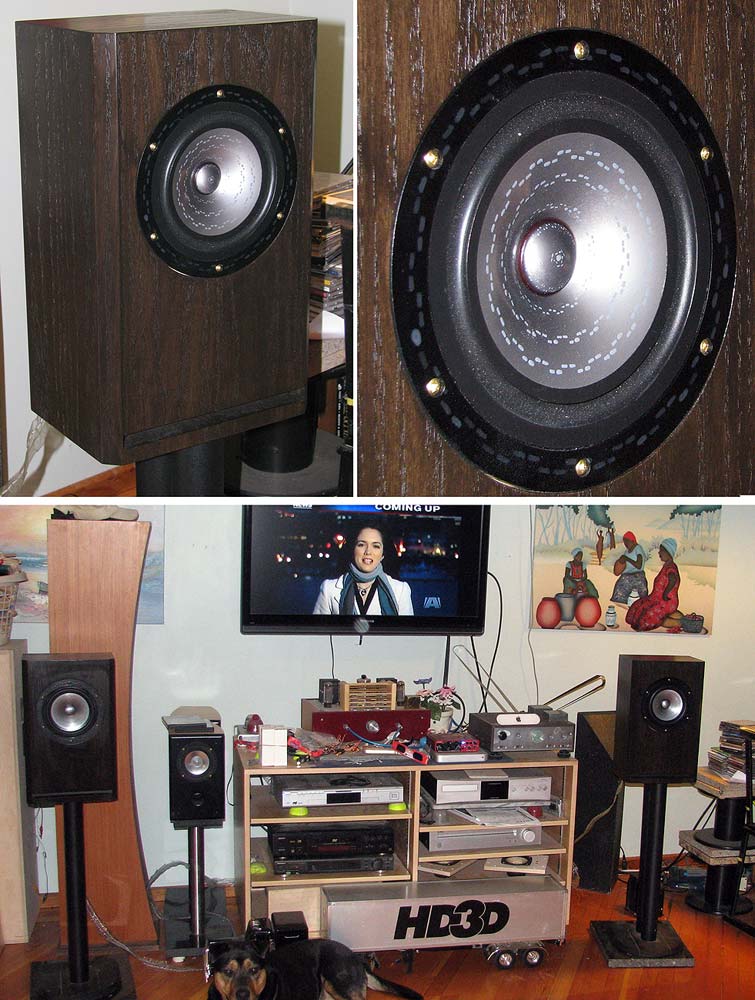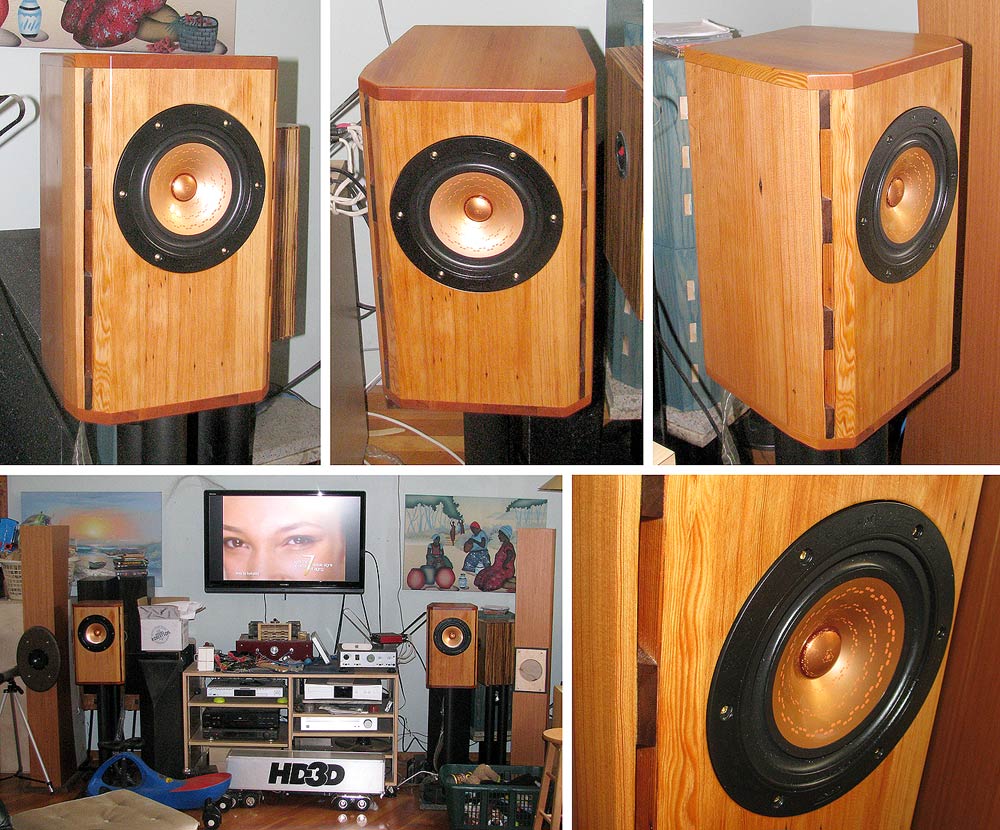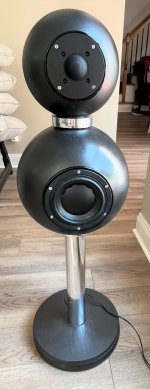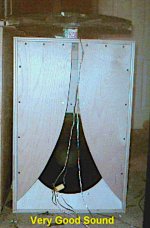http://www.gedlee.com/downloads/The Perception of Distortion.pdf
I'm a big fan of the Gedlee works on distortion perception. I've been preaching that low order nonlinear distortion is much preferable (less audible) to high order nonlinear distortion for a long time. This shouldn't be a surprise to most of you. Especially SET fans such as myself. 😱
What should be a surprise though- is that nonlinear distortion (THD & IMD) is most audible at low listening levels!
Gedlee's work appears to claim that speakers sound worse at higher levels not from nonlinear distortions (obviously this would have it's limits), but from diffraction! Diffraction appears to be more audible as you increase SPL!
So most of us know it's optimal to: round over our baffle edges, not use squares, offset drivers, etc. but I'm going to investigate directivity's influence on baffle diffraction. Mathematically, there should be an optimal baffle size to driver size, as larger drivers will beam frequencies sooner than smaller drivers.
This is of large importance and also a substantial advantage to fullrange drivers! Diffraction mostly effects higher frequencies. A driver which will beam higher frequencies, which would be effected by baffle diffraction, will in theory mitigate effects of diffraction. Much work has been done on constant directivity designs- but it may be the diffractions effects are most audible with acoustically small radiators with a high frequency passband. Obviously these would have wide directivity; maximally influenced by baffle diffraction. Ironically this would be all normal dome and ring tweeters.
I would also like to point out that many people have preferred smaller baffles to larger baffles. Gedlee's work not only suggests that diffraction is more audible the more it causes linear distortion (peaks and dips in frequency response)- but audibility increases with time!
A larger baffle will require a frequency to travel longer before it is radiated as baffle diffraction; therefore increasing time until radiation. This may be a large reason many have preferred smaller baffles! (Other than WAF 😛)
To be continued..
Edit: Full chart & conclusions in post #3.
I'm a big fan of the Gedlee works on distortion perception. I've been preaching that low order nonlinear distortion is much preferable (less audible) to high order nonlinear distortion for a long time. This shouldn't be a surprise to most of you. Especially SET fans such as myself. 😱
What should be a surprise though- is that nonlinear distortion (THD & IMD) is most audible at low listening levels!
Gedlee's work appears to claim that speakers sound worse at higher levels not from nonlinear distortions (obviously this would have it's limits), but from diffraction! Diffraction appears to be more audible as you increase SPL!
So most of us know it's optimal to: round over our baffle edges, not use squares, offset drivers, etc. but I'm going to investigate directivity's influence on baffle diffraction. Mathematically, there should be an optimal baffle size to driver size, as larger drivers will beam frequencies sooner than smaller drivers.
This is of large importance and also a substantial advantage to fullrange drivers! Diffraction mostly effects higher frequencies. A driver which will beam higher frequencies, which would be effected by baffle diffraction, will in theory mitigate effects of diffraction. Much work has been done on constant directivity designs- but it may be the diffractions effects are most audible with acoustically small radiators with a high frequency passband. Obviously these would have wide directivity; maximally influenced by baffle diffraction. Ironically this would be all normal dome and ring tweeters.
I would also like to point out that many people have preferred smaller baffles to larger baffles. Gedlee's work not only suggests that diffraction is more audible the more it causes linear distortion (peaks and dips in frequency response)- but audibility increases with time!
A larger baffle will require a frequency to travel longer before it is radiated as baffle diffraction; therefore increasing time until radiation. This may be a large reason many have preferred smaller baffles! (Other than WAF 😛)
To be continued..
Edit: Full chart & conclusions in post #3.
Last edited:
So one must care for distortion of amplifiers and loudspeakers at lo levels, too, say from 100 electrical pW and 10dB SPL on upwards.What should be a surprise though- is that nonlinear distortion (THD & IMD) is most audible at low listening levels!
Optimum baffle is spherical, the driver(s each) having only a fraction of baffle diameter and so not much spoiling spherical shape. A symmetrical polyeder with 26 facets, 8 of them triangular, is a good and simple-to-build approximation of a sphere.So most of us know it's optimal to: round over our baffle edges, not use squares, offset drivers, etc. but I'm going to investigate directivity's influence on baffle diffraction. Mathematically, there should be an optimal baffle size to driver size, as larger drivers will beam frequencies sooner than smaller drivers.
Hey all!
After crunching a ton of numbers, I have the raw data for everyone here. I have created this chart for the public domain; feel free to copy and post it anywhere.
We know that baffle diffraction is more audible the more it is delayed in time. So to optimize this fact, we should use the smallest baffle possible for a radiator of a given diameter.
To simplify the math, I made the baffles the same width of the acoustic radiator. Of course, this is unrealistic, but all we really want to see here is trendlines.
I should note that driver directivity is more complex than the equations I used alone, but will generally be relevant to most cone and dome radiators. Other factors affecting cone radiator directivity is cone depth, with a larger depth producing more directivity.
Here is the raw data:
Effected Bandwidth By Acoustic Radiator Size vs Baffle

You can see that larger acoustic radiators on the smallest baffle possible have a bandwidth that is affected the least by diffraction. Inversely, the smallest acoustic radiators on the smallest baffle possible have a bandwidth that is affected the most by diffraction.
We can also see that the affected bandwidth rapidly decreases with increasing cone diameter.
A 2" fullrange radiator has half the affected bandwidth of a 1" fullrange radiator. A 5" radiator has half the affected bandwidth of a 2" radiator. A 10" radiator has half the affected bandwidth of a 5" radiator.
Thus, all else being equal, larger fullrange drivers will have less diffraction related distortions.
After crunching a ton of numbers, I have the raw data for everyone here. I have created this chart for the public domain; feel free to copy and post it anywhere.
We know that baffle diffraction is more audible the more it is delayed in time. So to optimize this fact, we should use the smallest baffle possible for a radiator of a given diameter.
To simplify the math, I made the baffles the same width of the acoustic radiator. Of course, this is unrealistic, but all we really want to see here is trendlines.
I should note that driver directivity is more complex than the equations I used alone, but will generally be relevant to most cone and dome radiators. Other factors affecting cone radiator directivity is cone depth, with a larger depth producing more directivity.
Here is the raw data:
Effected Bandwidth By Acoustic Radiator Size vs Baffle

You can see that larger acoustic radiators on the smallest baffle possible have a bandwidth that is affected the least by diffraction. Inversely, the smallest acoustic radiators on the smallest baffle possible have a bandwidth that is affected the most by diffraction.
We can also see that the affected bandwidth rapidly decreases with increasing cone diameter.
A 2" fullrange radiator has half the affected bandwidth of a 1" fullrange radiator. A 5" radiator has half the affected bandwidth of a 2" radiator. A 10" radiator has half the affected bandwidth of a 5" radiator.
Thus, all else being equal, larger fullrange drivers will have less diffraction related distortions.
Last edited by a moderator:
Gedlee's work appears to claim that speakers sound worse at higher levels not from nonlinear distortions (obviously this would have it's limits), but from diffraction! Diffraction appears to be more audible as you increase SPL!
I'm skeptical, because if you compare a speaker with a single driver, to a speaker with more than one of the same driver, lets say 4 in a line array, then, according to this theory, it would be reasonable to surmise that distortion will increase simple because you have more baffle, the opposite is in fact true.
Well we can objectively state that baffle step diffraction certainly does create peaks and dips in the frequency response (linear distortion). We also can objectively state that generally the smoother and flatter a frequency response is, the higher likelihood an average of many individuals will prefer said speaker.
I also know that I can pass a blind test with 99% confidence down to a .5dB change in amplitude.
Blind Tests
Either way, even if Gedlee's white paper is wrong, it is still optimal to reduce baffle step diffraction distortions.
As Grasso pointed out, a sphere will have the least baffle step diffractions. Although, this comes with the compromise that internal standing waves in a sphere are the worst possible. I think the "hyper-cube" design is a nice middle-ground, because it has no parallel surfaces to my knowledge. Although, either a sphere or "hypercube" will have limitations due to internal volume.
I also know that I can pass a blind test with 99% confidence down to a .5dB change in amplitude.
Blind Tests
Either way, even if Gedlee's white paper is wrong, it is still optimal to reduce baffle step diffraction distortions.
As Grasso pointed out, a sphere will have the least baffle step diffractions. Although, this comes with the compromise that internal standing waves in a sphere are the worst possible. I think the "hyper-cube" design is a nice middle-ground, because it has no parallel surfaces to my knowledge. Although, either a sphere or "hypercube" will have limitations due to internal volume.
Last edited:
Diffraction AND interference spoil the the response and distortion of most
speakers. When you think of a speaker, think of it as a chorus of speakers
with 4mm diameter.
going to read the paper...
speakers. When you think of a speaker, think of it as a chorus of speakers
with 4mm diameter.
going to read the paper...
Made this pair of 2-sphere speakers, only the larger sphere is needed for baffling, the smaller sphere has a sealed dome tweeter. A pole running through the spheres mitigates internal waves, as well as a 3-part damping system. The mid woofer is has a 3" coil and very little cone aspect (goes flat down to 100Hz), so it radiates the mids better than traditional cones. It's crossed at 100Hz with 12 db slope with a subwoofer. At 2,000 Hz it's crossed with the 1 1/8" dome tweeter, again 12 db slopes. The vocals (first harmonics) all come from one driver. The drivers' diaphragm shapes coupled with the spheres make these very low diffraction.
Attachments
Not Correct.What should be a surprise though- is that nonlinear distortion (THD & IMD) is most audible at low listening levels!
Masking effects audibility of nonlinear distortion.
True at low levels there is less masking.
But what you leave out is at low levels there is less nonlinear distortion to mask. I do not know why this part is often left out.
Thanks DT
I would think these effects increase with amplitude and the associated excursion of drivers although more audible with larger drivers with more mass
The thesis doesn't sound realistic from my personal experience.
I've listened to speakers that suffer from horrible baffle geometry (-> lots of diffraction) that sound perfectly clean from very low to very high SPLs, and the exact opposite, speakers with great constant directivity, meaning little to no diffraction, that sound horribly distorted.
Also, I have, with various DIY projects, tested for example midwoofers of the same size in the same enclosure, and they sound distinctly different - some very clean, some very crappy. Diffraction doesn't change with same sized cone speakers in the same enclosure, but they were different speakers from different brands, meaning different contruction of drives, different materials etc. - which is obviously what made the difference in subjective sound.
Pretty sure many or most of us gained similar experiences over their DIY "careers".
I've listened to speakers that suffer from horrible baffle geometry (-> lots of diffraction) that sound perfectly clean from very low to very high SPLs, and the exact opposite, speakers with great constant directivity, meaning little to no diffraction, that sound horribly distorted.
Also, I have, with various DIY projects, tested for example midwoofers of the same size in the same enclosure, and they sound distinctly different - some very clean, some very crappy. Diffraction doesn't change with same sized cone speakers in the same enclosure, but they were different speakers from different brands, meaning different contruction of drives, different materials etc. - which is obviously what made the difference in subjective sound.
Pretty sure many or most of us gained similar experiences over their DIY "careers".
http://www.gedlee.com/downloads/The Perception of Distortion.pdf
I'm a big fan of the Gedlee works on distortion perception. I've been preaching that low order nonlinear distortion is much preferable (less audible) to high order nonlinear distortion for a long time. This shouldn't be a surprise to most of you. Especially SET fans such as myself. 😱
What should be a surprise though- is that nonlinear distortion (THD & IMD) is most audible at low listening levels!
Gedlee's work appears to claim that speakers sound worse at higher levels not from nonlinear distortions (obviously this would have it's limits), but from diffraction! Diffraction appears to be more audible as you increase SPL!
So most of us know it's optimal to: round over our baffle edges, not use squares, offset drivers, etc. but I'm going to investigate directivity's influence on baffle diffraction. Mathematically, there should be an optimal baffle size to driver size, as larger drivers will beam frequencies sooner than smaller drivers.
This is of large importance and also a substantial advantage to fullrange drivers! Diffraction mostly effects higher frequencies. A driver which will beam higher frequencies, which would be effected by baffle diffraction, will in theory mitigate effects of diffraction. Much work has been done on constant directivity designs- but it may be the diffractions effects are most audible with acoustically small radiators with a high frequency passband. Obviously these would have wide directivity; maximally influenced by baffle diffraction. Ironically this would be all normal dome and ring tweeters.
I would also like to point out that many people have preferred smaller baffles to larger baffles. Gedlee's work not only suggests that diffraction is more audible the more it causes linear distortion (peaks and dips in frequency response)- but audibility increases with time!
A larger baffle will require a frequency to travel longer before it is radiated as baffle diffraction; therefore increasing time until radiation. This may be a large reason many have preferred smaller baffles! (Other than WAF 😛)
To be continued..
Edit: Full chart & conclusions in post #3.
Diffraction affects mids as well esp vocals
The simple act of placing your hands either side of your mouth even flat will change the timbre of your voice
So do baffles
internal standing waves in spheres can be mitigated by placing an object like a ball in the sphereWell we can objectively state that baffle step diffraction certainly does create peaks and dips in the frequency response (linear distortion). We also can objectively state that generally the smoother and flatter a frequency response is, the higher likelihood an average of many individuals will prefer said speaker.
I also know that I can pass a blind test with 99% confidence down to a .5dB change in amplitude.
Blind Tests
Either way, even if Gedlee's white paper is wrong, it is still optimal to reduce baffle step diffraction distortions.
As Grasso pointed out, a sphere will have the least baffle step diffractions. Although, this comes with the compromise that internal standing waves in a sphere are the worst possible. I think the "hyper-cube" design is a nice middle-ground, because it has no parallel surfaces to my knowledge. Although, either a sphere or "hypercube" will have limitations due to internal volume.
Plus in order for a sphere to resonate it must actual pulse in and out and this is very hard as it is the strongest geo shape and lacks the joints that box speakers have
tested for example midwoofers of the same size in the same enclosure, and they sound distinctly different
We tested the same driver, same alignment in 2 different encosures. They broadly sounded the sam ebut it was clear that the enclosure that is designed to minimize (at least some) of the diffraction. The more rectangular loudpeaker was much eeasy to locate, the trapezoid disappeared.


dave
We tested the same driver, same alignment in 2 different encosures. They broadly sounded the sam ebut it was clear that the enclosure that is designed to minimize (at least some) of the diffraction. The more rectangular loudpeaker was much eeasy to locate, the trapezoid disappeared.
Did the effect / difference increase with SPL, as Geddes and Lee suggest?
The OP explains that nonlinear distortion would be more audible at low SPL. We all know however from practical experience that loudspeakers sound less clean, the louder they play, up to a point where they get so distorted / dirty sounding that you voluntarly stop increasing the volume. OP suggests that audible effect is not nonlinear distortion, but rather diffraction, which, as opposed to non-linear distortion, is supposed to get more noticeable with increasing SPL.
Too bad the link to the original paper is dead. I would love to have known where their assumptions and conclusions came from and what evidence they are based on.
Found it: http://www.gedlee.com/Papers/The Perception of Distortion.pdf
And read it.
I won't quote anything here, since I think it wouldn't be beneficial for the community to do so. Their conclusions were based on listening tests. These seem sort of simplified / suspect.
Their work has not been adopted, and while I agree and the popular consensus is that nonlinear distortion cannot predict subjective listening impression in a detailed way, still everyone agrees that it is the limiting factor in loudspeaker Max. SPL capabilities, and all the serious magazines do distortion limited SPL measurements to gage how loud a loudspeaker can play cleanly - NOT, as suggested here, linear distortion (amplitude and phase frequency response on and off axis).
Still, eliminating baffle diffraction is one of the basics of loudspeaker design, so nobody would be wise to neglect optimizing that design aspect, no matter the added influence Geddes claims.
And read it.
I won't quote anything here, since I think it wouldn't be beneficial for the community to do so. Their conclusions were based on listening tests. These seem sort of simplified / suspect.
Their work has not been adopted, and while I agree and the popular consensus is that nonlinear distortion cannot predict subjective listening impression in a detailed way, still everyone agrees that it is the limiting factor in loudspeaker Max. SPL capabilities, and all the serious magazines do distortion limited SPL measurements to gage how loud a loudspeaker can play cleanly - NOT, as suggested here, linear distortion (amplitude and phase frequency response on and off axis).
Still, eliminating baffle diffraction is one of the basics of loudspeaker design, so nobody would be wise to neglect optimizing that design aspect, no matter the added influence Geddes claims.
Did the effect / difference increase with SPL, as Geddes and Lee suggest?
Didn’t notice.
dave
Is this such a surprise?
Distortion is always a lower sub-set in audibility than just plain frequency response manipulation.
Since the relative difference in level is MUCH lower as well.
Where on-axis has an higher weighting than off-axis.
Although the combination (= directivity) is also very important.
Obviously to some extend, but as Geddes describes well, the masking effect is pretty strong.
Diffraction doesn't only mess up the energy of the off-axis response (creating another sound source), but can also effect the on-axis response as well.
Or rather the combination of the two is what I mean.
Very often resulting in a dip on-axis, while flat off-axis.
Or flat on-axis and resulting in a peak off-axis.
You can't disconnect diffraction from this behavior.
I always design with such a "priority list" of importance of audibility in mind.
A good frequency response as well as directivity are high on that list.
As well as no major issues with resonances/standing waves/interference issues.
All other things come later.
Btw, I don't understand how diffraction effects and "sounding distorted" can be in one sentence?
Those are fundamentally two totally different things?
Distortion is always a lower sub-set in audibility than just plain frequency response manipulation.
Since the relative difference in level is MUCH lower as well.
Where on-axis has an higher weighting than off-axis.
Although the combination (= directivity) is also very important.
Obviously to some extend, but as Geddes describes well, the masking effect is pretty strong.
Diffraction doesn't only mess up the energy of the off-axis response (creating another sound source), but can also effect the on-axis response as well.
Or rather the combination of the two is what I mean.
Very often resulting in a dip on-axis, while flat off-axis.
Or flat on-axis and resulting in a peak off-axis.
You can't disconnect diffraction from this behavior.
I always design with such a "priority list" of importance of audibility in mind.
A good frequency response as well as directivity are high on that list.
As well as no major issues with resonances/standing waves/interference issues.
All other things come later.
Btw, I don't understand how diffraction effects and "sounding distorted" can be in one sentence?
Those are fundamentally two totally different things?
In my experience, reducing diffraction opens up the soundstage which is a good thing.
- Home
- Loudspeakers
- Full Range
- Diffraction Is More Audible Than Nonlinear Distortion!?

